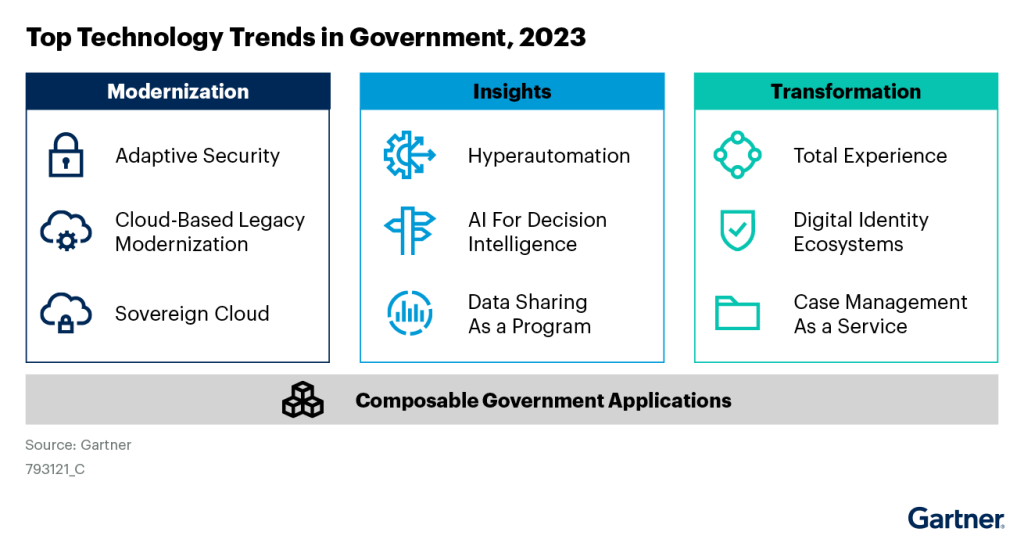
Top Technology Trends in Government for 2023
Top Technology Trends in Government for 2023
Aimed at CIOs, digital leaders and decision makers in Government organizations, this new Gartner research identifies the top technology trends emerging in 2023, provides strategic planning assumptions, analysis and recommendations on action to take now.
Overview
Gartner research finds that:
- “2023 brought no pause for government leaders and executives. Global turmoil, regional conflicts and local pressures amplify the need to sustain and steer digital transformation investments toward policy priorities.”
- “Emerging “post-digital” government developments mean that investments are expected to show tangible impacts on transformation of constituent services, use of data for insights and decisions, and modernization of digital infrastructures and information systems.”
- “Government CIOs are pressured to prove mission relevance and impact of their technology initiatives and capabilities — all while dealing with sector-specific challenges like low digital maturity, eroding citizen trust, scarcity of talent and persistent difficulties in scaling innovation.”
The research groups top trends into three priority areas:
- Modernization
- Insights
- Transformation
Highlights from these areas are shared in this article.

Modernization
Gartner research finds that “the focus on modernization of government infrastructures and information systems is not new. But the urgency has accrued since 2020 when the pandemic exposed massive-scale vulnerabilities in government processes and information systems. It laid bare structural inabilities to rapidly scale operations in the face of new and rapidly shifting demands.”
Adaptive Security
Gartner research describes the adaptive security model as “one in which cybersecurity tools, techniques and talent merge to operate more like an autonomic biological immune system and continually adjust to the evolving threat landscape. An adaptive security architecture features components for identification, protection, detection, response and recovery; it forgoes traditional notions of perimeter and assumes there is no boundary for safe and unsafe.”
One of the reasons that adaptive security is included as trending is that “Government agencies are among the top targets for attack and face evolving threats, rapid advances in tools, updated compliance frameworks and updated strategies, cumulatively pressuring them to evaluate their cybersecurity capabilities and embrace adaptive security.”
Recommended actions include:
- “Overcome any lingering resistance to the adoption of adaptive security by linking its value to broader objectives, such as digital innovation, transformation, national security and organizational resilience.”
- “Adopt an integrated, risk-based security approach by collaborating with leaders for physical, personnel and supply chain security. In addition, collaborate with mission units for CPS, whether created by OT/IT convergence, Internet of Things (IoT), industrial IoT or “smart” programs.”
- “Focus policy and practices on essential activities by emphasizing tools, techniques, response capabilities and talent. Where allowable and practicable, deprioritize document-based compliance activities.”
- “Address the essential human element and develop a cybersecurity culture. Grow expertise from within through in-depth training programs and broad employee support through engaging awareness education.”
Cloud-based legacy modernization
Strategic Planning Assumption: “By 2025, over 75% of governments will operate more than half of workloads using hyperscale cloud providers.”
Gartner research describes cloud-based legacy modernization as where “efforts to modernize legacy applications are being accelerated by the strategic use of cloud delivery models to improve government services, shorten implementation times, reduce technical debt and reduce operational risk levels. A legacy application is an application that is based on outdated technologies, yet remains critical to current operations.”
Gartner research identifies several reasons why this is a top technology trend for governments in 2023:
- “Legacy modernization remains the aspiration for many governments as maintaining antiquated systems represent a risk and cost to the organization and can undermine the overall resilience of government service delivery.”
- “The pandemic sped up the public-sector adoption of cloud solutions and the “anything as a service” (XaaS) model for accelerated legacy modernization and new service implementations. It provides scalability and a shorter time to value for delivering digital government at scale.”
- “A cloud-based delivery model shifts capital expenditure (capex) IT investment “heavy lifts” to a more consistent pay-as-you-go operating expenditure (opex) funding mechanism. This normalizes IT spend over time, making budgeting for IT more predictable, while avoiding the accrual of technical debt.”
- “A cloud-based delivery model improves the government agility and the pace at which new capabilities can be delivered and the availability of the resources required to support them.”
Gartner research finds that one of the implications of this trend include “Innovation opportunities — Cloud-based solutions open new opportunities for innovation and transformation of business processes.”
The research identifies actions including:
- “Establish a continuous modernization program that includes organizational change management by ensuring strong governance and sponsorship by business and IT leaders.”
- “Implement a multicloud strategy inclusive of integration management to mitigate complexities of Incremental modernization across multiple system residences. Leverage adaptive sourcing strategies to maximize choices for use of internal and external resources.”
- “Secure executive commitment to continued financing for subscription-based services in operational budgeting to mitigate the risks caused by a shift from capital to operational IT investment strategies.”
- “Demonstrate value for cost through mission outcome performance metrics as part of the budget request process and to manage performance of service providers on an ongoing basis.”
Insights
“The insights theme picks up ongoing shifts from traditional data collection and reporting toward greater sharing, reuse and advanced analytics across government. AI continues to evolve at a rapid pace.”
“In the wake of postdigital developments, Government CIOs must rapidly evolve and steer their data and analytics (D&A) investments toward critical insights for core mission needs.”
Included within the Insights theme, is the top technology trend of “AI for Decision Intelligence”.
AI for Decision Intelligence
Gartner research describes AI for decision intelligence as “the measured, systematic use of AI as a component of improving government mission achievement faster, more accurately and with sustainable resource use. It is a practical discipline that improves decision making by explicitly understanding how decisions are made and how their outcomes are evaluated and improved by feedback. It applies to all major levels of decision types: one-off strategic decisions, managerial decisions and high-volume operational decisions.”
The research finds that the emergence of large language models (LLMs) “have made AI use at operational level a highly visible opportunity, with the tools now available raising the expectation that they can be used for service delivery and policy processes.”
This trend is identified as having several implications:
- “AI and data and analytics (D&A) capabilities are often treated separately from service delivery and operational processes, frequently in separate organizations. Decision intelligence requires this to change. The desire to exploit LLMs will accelerate this.”
- “Using AI to engineer decisions for precision, transparency, traceability, flexibility, reusability and explainability will significantly empower and improve governance.”
- “The ability to identify, prioritize and then model and (re)engineer decisions for improvement are critical competencies for a future-ready organization.”
- “Changing how decisions are made can significantly impact the role of decision makers. Government CIOs must anticipate and proactively manage these decisions through coaching and training.”
- “AI and data analytics with decision intelligence will become a core business function in government.”
Actions for CIOs:
- “Drive a policy around how to govern the safe exploration and use of new tools — including LLMs — throughout the organization.”
- “Develop a future-state vision of the business value and public benefit of decision intelligence by building a D&A strategy with integrated policies and focus on desired policy outcomes.”
- “Improve decision making by combining humans and AI decision-making capabilities and a feedback loop for measuring results.”
- “Start where business-critical decision making must be improved — requiring more data-driven support and AI-powered augmentation — and determine where decisions can be scaled and accelerated through automation.”
- “Alternatively, start where there is the greatest dissatisfaction with current decision making, driving a willingness to change how those decisions are made.”
Data Sharing as a Program
Gartner research describes this top trend: “Data sharing centers around bringing together data sources to allow cross-analysis in order to create additional value to outcomes across government. Data sharing in government overall is often ad hoc, driven by high-profile incidents. By contrast, data sharing as a program is a systematic and scalable approach to enable data reuse and services innovation through incentives and sponsorship, standards and platforms, governance and sustainable innovation pipelines.”
Data sharing as a program is trending in 2023 for governments because:
- “The quality of many government responses to the pandemic was determined by the ability to share data beyond organizational boundaries. Subsequent economic, environmental and health challenges — not to mention political instability — continue to put pressure on many governments. Leveraging timely and accurate data across multiple fronts is therefore becoming even more critical.”
- “The big value in government, as in the commercial arena, has been gained from data using consent and (near) real-time access to drive innovation and improve service delivery.”
- “Previous obstacles and barriers to data sharing have proven to be surmountable, so it is now clear that acting at scale is achievable.”
The implications of an increasingly programmatic approach to data sharing include:
- “Sharing requires compromise, strong sponsorship and political leadership. This means proactively working with stakeholders, accepting risks in return for benefits and developing responsibility for delivering value from data sharing.”
- “Government must put in place the governance required to address the ethical challenges that may differ from one government organization to the next based on the data they maintain.”
- “The prominent culture of compartmentalization for security reasons needs to be shifted to use of data to serve citizens and accelerate improvements.”
- “Agencies without a strong track record in data sharing should identify “quick win” opportunities that illustrate tangible early value beyond mere compliance. Where possible, develop or exploit central resources like communities of practice or data/AI innovation programs. This is what “data sharing as a program” means, and is critical for success.”
Actions for Government CIOs to address this opportunity:
- “Strengthen executive support and buy-in from mission leaders by building a pipeline of use cases that have a clear line of sight to critical outcomes across government.”
- “Enhance the quality and efficiency of data sharing at scale by improving the rules and structures that govern it such that they are consistent, easy to follow and clearly based on a transparent balance of benefit and risk.”
- “Raise the maturity of data and analytics capabilities across the organization by ensuring that relevant toolsets and skills are available to support nontraditional specialists, notably business technologists and analysts in operational departments.”
- “Ensure continuing support of the initiatives through changes in leadership or administration with a constant emphasis on discovering new value from existing or accessible data.”
Transformation
“The transformation theme relates to making public sectors more responsive to constituent and societal needs. Service delivery approaches have traditionally been of low maturity, characterized by siloed and disjointed initiatives and a culture that does not encourage innovation in delivering services or empathy toward a citizen and their contextual needs.”
Digital Identity Ecosystems
Included within the theme of Transformation, is the Digital Identity Ecosystems trend.
Gartner research finds that: “Traditionally siloed identity domains within government and beyond — commercial, financial, healthcare, education — are increasingly interacting, overlapping and sometimes also colliding. In the emerging digital identity ecosystems, government organizations at all levels are facing new responsibilities to ensure trust, innovation and equitable access to services.”
“Adoption of digital identity increases where it is available for highly relevant services and it is trusted. Elsewhere, adoption stalls, and public services suffer from inefficiencies and the risk of fraud.”
“The divergent interests of ecosystem actors unsettle passive, less-mature government organizations with many shying away from investing into advanced capabilities to foster trust and adoption among citizens. More proactive governments take on the challenge by federating, facilitating or exploring new ways of collaboration and regulation as digital identity ecosystems evolve.”
“Investments into portable and interoperable identity are accelerating across both public and private sectors with geographies like the EU and Canada taking the lead. But consensus has yet to emerge on approaches and objectives for digital identity programmes — for example, mobile driving licenses versus general-purpose identity wallets; centralized versus decentralized identity provisioning.”
Implications of this trend include:
- “Governments need to balance issues like making access to public services secure and convenient, fighting fraud and protecting personal privacy, ensuring national (digital) sovereignty and promoting technology innovation in a rapid growth market.”
- “The critical success factor for adoption is linking digital identity to salient use cases. Ideal use cases are often thought of being those with high frequency of use or a high target population. But as a noncommercial actor, the government must also serve small or marginalized user groups.”
- “Future identity use cases must be cross-sector and cross-jurisdiction to be relevant. This requires breaking out of past identity silos where organizations and sectors used to build their own schemes. Government should use its privileged position to act as a facilitator, federator or regulator of the emerging ecosystems.”
Composable Government Applications
Underpinning the priority areas of Modernization, Insights and Transformation, Gartner research identifies an additional trend for Composable Government Applications.
Composable applications are described as: “architected and licensed in a modular fashion, using approaches such as packaged business capabilities, and allow organizations to configure and reconfigure components to meet the evolving needs of the organization. In government organizations, this architectural approach enables organizations to create their own or use preexisting, independent components to drive innovation and respond to changing requirements and expectations related to reform and modernization.”
Strategic Planning Assumption: “By 2025, over 35% of government legacy applications will be replaced by solutions developed on low-code application platforms and maintained by fusion teams.”
Gartner research finds this to be trending because:
- “Composable applications provide government organizations with an agile, modular approach to modernize legacy applications in order to reduce risk and costs associated with ongoing support and maintenance of these systems.”
- “Establishing a composable, digital government technology platform-driven approach to application architecture enables governments to maximize investments in technical capabilities and drive continuous service and application improvement.”
Gartner, Top Technology Trends in Government for 2023, Arthur Mickoleit, Irma Fabular, and 7 more, 31 May 2023. GARTNER is a registered trademark and service mark of Gartner, Inc. and/or its affiliates in the U.S. and internationally and is used herein with permission. All rights reserved.
To find out more:
- Learn more about Microsoft’s AI platform, services, and solutions
- Find out how Microsoft can help you meet sovereign requirements in the cloud
- Learn more about Microsoft’s low-code development platform
About the Center of Expertise
Microsoft’s Public Sector Center of Expertise brings together thought leadership and research relating to digital transformation in the public sector. The Center of Expertise highlights the efforts and success stories of public servants around the globe, while fostering a community of decision makers with a variety of resources from podcasts and webinars to white papers and new research. Join us as we discover and share the learnings and achievements of public sector communities.
Questions or suggestions?






